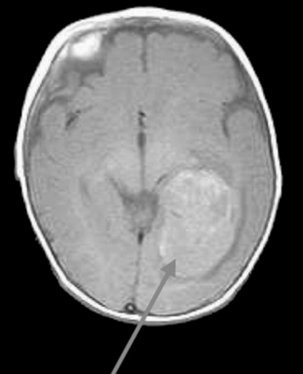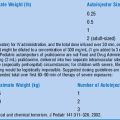Chapter 15 Headache
2 Are the international headache society (IHS) criteria for the diagnosis of migraine headache applicable to children?
3 List the criteria for pediatric migraine without aura.
4 List the criteria for pediatric migraine headache with aura.
9 How will I recognize the child with a brain tumor headache?
Brain tumors are an uncommon but feared cause of headaches in children. Certain features help to distinguish a headache that is caused by a tumor (Fig. 15-1) or other intracranial mass:
 Location—occipital headaches or headaches localized to the nape of the neck
Location—occipital headaches or headaches localized to the nape of the neck
 Worsening with sneezing, coughing, or straining
Worsening with sneezing, coughing, or straining
 Timing—headaches that awaken the child from sleep or that are worse in the morning and improve on arising
Timing—headaches that awaken the child from sleep or that are worse in the morning and improve on arising
 Positioning—headaches that worsen with body movement, especially bending forward, and improve with change in position
Positioning—headaches that worsen with body movement, especially bending forward, and improve with change in position
 Headaches associated with blurred vision
Headaches associated with blurred vision
 Change over time—headaches that change in frequency, severity, or characteristics
Change over time—headaches that change in frequency, severity, or characteristics
Honig PJ, Charney EB: Children with brain tumor headaches. Am J Dis Child 136:121–124, 1982.
10 Are chronic daily headaches common in children?
 Transformed migraine: Daily headache with average duration of 4 hours for more than a month, and a history of increased headache frequency with decreased migraine symptoms
Transformed migraine: Daily headache with average duration of 4 hours for more than a month, and a history of increased headache frequency with decreased migraine symptoms
 Chronic tension-type headache (ICHD-2 2.3): History of episodic tension-type headache in the past with evolution to daily headaches
Chronic tension-type headache (ICHD-2 2.3): History of episodic tension-type headache in the past with evolution to daily headaches
 New daily persistent headache (ICHD-2 4.8): Acute onset of headache on more than 15 days per month lasting at least 4 hours and without history of migraine or tension-type headache in the past
New daily persistent headache (ICHD-2 4.8): Acute onset of headache on more than 15 days per month lasting at least 4 hours and without history of migraine or tension-type headache in the past
 Hemicrania continua (ICHD-2 4.7): Unilateral, continuous headache of moderate severity known for its absolute relief with indomethacin
Hemicrania continua (ICHD-2 4.7): Unilateral, continuous headache of moderate severity known for its absolute relief with indomethacin
Seshia SS: Chronic daily headache in children and adolescents. Can J Neurol Sci 31:319–323, 2004.
12 What is the role of emergent neuroimaging in children with headache?
 Persistent headaches of >6-month duration that have not responded to medical treatment
Persistent headaches of >6-month duration that have not responded to medical treatment
 Headache associated with abnormal neurologic findings, especially papilledema, nystagmus, or gait or motor abnormalities
Headache associated with abnormal neurologic findings, especially papilledema, nystagmus, or gait or motor abnormalities
 Persistent headaches not associated with a family history of migraine
Persistent headaches not associated with a family history of migraine
 Headaches that awaken a child from sleep or are present immediately on awakening
Headaches that awaken a child from sleep or are present immediately on awakening
 Persistent headache associated with episodes of confusion, disorientation, or vomiting
Persistent headache associated with episodes of confusion, disorientation, or vomiting
 Family history or medical history of disorders predisposing one to central nervous system (CNS) lesions (such as neurofibromatosis)
Family history or medical history of disorders predisposing one to central nervous system (CNS) lesions (such as neurofibromatosis)
 Clinical or laboratory findings suggestive of CNS involvement
Clinical or laboratory findings suggestive of CNS involvement
15 What treatments are available for migraine headaches?
Barnes N, Millman G, James E: Migraine headache in children. Clin Evid 10:429–443, 2003.












